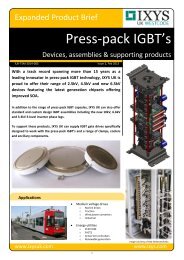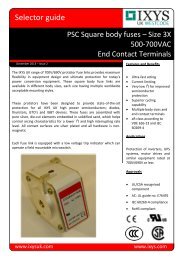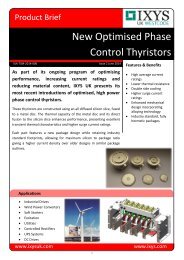isolated current voltage transducers
You also want an ePaper? Increase the reach of your titles
YUMPU automatically turns print PDFs into web optimized ePapers that Google loves.
Other Types of Voltage Transducers Technologies<br />
6.2.3 Typical applications<br />
Presently, the main market for the AV 100 is in traction<br />
inverters, but they can also be used in or adapted for any<br />
industrial application.<br />
• Auxiliary and main converters (input <strong>voltage</strong>, DC link,<br />
output phase <strong>voltage</strong>s).<br />
• Chopper and power factor correction circuits.<br />
• Battery chargers.<br />
• Sub-Stations and others.<br />
6.2.4 Calculations & Properties<br />
Calculation of the measuring resistor RM<br />
The AV 100 family provides a <strong>current</strong> output. This <strong>current</strong><br />
can be transformed into a <strong>voltage</strong> with the addition of a<br />
measuring resistor, R M<br />
, at the output which cannot exceed a<br />
defined R Mmax<br />
value, based on the available <strong>voltage</strong> at the<br />
transducer supply and the maximum <strong>voltage</strong> measured. For<br />
the AV 100 family, R Mmax<br />
can be easily calculated using the<br />
following formula:<br />
R Mmax<br />
= ((V Cmin<br />
- 5.1) • V PN<br />
/ (V Pmax<br />
• I SN<br />
) - 31) • 0.9 [Ω]<br />
With:<br />
V Cmin<br />
= Minimum value of the secondary power supply [V]<br />
5.1 = Internal <strong>voltage</strong> drop of the electronics [V]<br />
V PN<br />
= Nominal measurable primary <strong>voltage</strong> [V]<br />
V Pmax<br />
= Maximum measurable primary <strong>voltage</strong> [V]<br />
I SN<br />
= Secondary output <strong>current</strong> at V PN<br />
[A]<br />
31 = Secondary internal resistance [Ω]<br />
0.9 = Safety factor [-]<br />
The R Mmax<br />
values indicated in the datasheets are the values<br />
calculated using V Pmax<br />
.<br />
+HT<br />
-HT<br />
Negative unipolar power supply<br />
In this case, the zener diode must be inserted as shown in<br />
Figure 51 and the zener <strong>voltage</strong>, V Z<br />
, must be greater than<br />
5.1 volts. The maximum measuring resistance becomes:<br />
R Mmax<br />
= [(abs(V Cmin<br />
) - 2.0 - V Z<br />
) • V PN<br />
/ (V Pmax<br />
• I SN<br />
) - 31] • 0.9<br />
with abs (V Cmin<br />
) corresponding to the absolute value of the<br />
V Cmin<br />
<strong>voltage</strong>.<br />
+HT<br />
-HT<br />
+HT<br />
-HT<br />
+HT<br />
-HT<br />
+<br />
M<br />
-<br />
Figure 50: Electric connection – AV 100 with positive unipolar<br />
power supply<br />
+<br />
M<br />
Figure 51: Electric connection – AV 100 with negative unipolar<br />
power supply<br />
-<br />
R M<br />
R M<br />
+Vc<br />
0V<br />
0V<br />
-Vc<br />
Unipolar Power Supply<br />
For unipolar <strong>voltage</strong> measurements the AV 100 family can<br />
operate from a unipolar secondary supply. A positive supply<br />
allows positive <strong>voltage</strong> measurements while a negative<br />
supply allows negative <strong>voltage</strong> measurements.<br />
Positive unipolar power supply<br />
In this case, a zener diode must be inserted as shown in<br />
Figure 50 and the zener <strong>voltage</strong>, V Z<br />
, must be greater than<br />
2.0 V. The maximum measuring resistance becomes:<br />
R M max<br />
= [(V Cmin<br />
- 5.1 - V Z<br />
) • V PN<br />
/ (V Pmax<br />
• I SN<br />
) - 31] • 0.9<br />
41

















